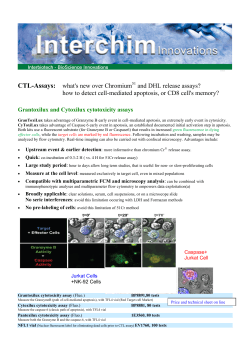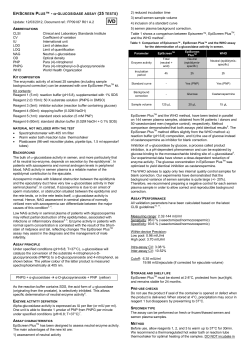
M T A K
MICROBIAL TRANSGLUTAMINASE ASSAY KIT Zedira GmbH Z009 Rösslerstraße 83 64293 Darmstadt Assay for the determination of microbial transglutaminase activity For in vitro research use only Revision: 21/05/2014 Intended use Reagent preparation Determination of microbial transglutaminase activity (MTG). Kit is sufficient for 3 x 11 measurements. Description Dissolve one vial of ACTIVITY REAGENT 1 (A1) in 5 ml of deionised water. Dissolve one vial of ACTIVITY REAGENT 2 (A2) in 1 ml of deionised water. Add 950 µL of the dissolved ACTIVITY REAGENT 2 (A2) to the vial of ACTIVITY REAGENT 1 (A1) and mix thoroughly. STOP REAGENT (S) is ready to use. Dissolve one vial of MICROBIAL TRANSGLUTAMINASES (P1) in 200 µL of deionised water. Use prepared reagents within 4 hours. New protocol! changes in red Transglutaminases are a family of enzymes that catalyse the posttranslational modification of proteins by inserting an isopeptide bond within or between polypeptide chains (Folk, J. E. and Cole, P. W., 1966). These enzymes catalyse the acyl transfer reaction between the carboxyamide group of peptide-bound glutamine residues and a variety of primary amines, particularly the -amino group of lysine (Lorand L. et al., 1962). The resulting cross link is of great significance, since it is highly stable and also resistant to mechanical and proteolytic degradation. Equipment The MICROBIAL TRANSGLUTAMINASE ASSAY KIT can be used in standard spectrophotometers with polystyrene 1 mL cuvettes. Refer to the instructions of the manufacturer. Assay procedure Prewarm for each sample 500 µL of ACTIVITY REAGENT for 10 minutes in suitable reaction tubes (1.5 mL) to 37°C before testing. Start the reaction by adding 50 µL of sample into 500 µL of ACTIVITY REAGENT. Use 50 µL of deionised water or buffer instead of sample to generate a blank. Stop the reaction exactly after 10 minutes by adding 500 µL of STOP REAGENT (S). Use a centrifuge to separate precipitations for 5 minutes, 10,000 x g at ambient temperature. The reaction mixture (1 mL) can be transferred to a suitable cuvette and measured at 525 nm. The MICROBIAL TRANSGLUTAMINASE (P1) is intended to be used for validating the efficacy and quality of the kit device. Use 50 µL of MICROBIAL TRANSGLUTAMINASE (P1) to maintain a volumetric activity of > 0.8 U/mL (ΔE525 nm > 0.33). See also a schematic assay overview on the next page. For reliable results ΔE525 nm of the samples should always be in the range from 0.1 to 0.9. Assay principle The MICROBIAL TRANSGLUTAMINASE ASSAY KIT uses Z-Gln-Gly as the amine acceptor substrate and hydroxylamine as amine donor. In the presence of MTG hydoxylamine is incorporated to form Z-glutamylhxdroxamate-glycine which develops a colored complex with iron (III) detectable at 525 nm. Results One unit of microbial transglutaminase activity is defined as the amount of enzyme, which causes the formation of 1.0 µmole of hydroxamate per minute by catalysing the reaction between Z-Gln-Gly and hydroxylamine at pH 6.0 at 37ºC (Folk and Cole, 1966). The results can be evaluated using following equation. U E V µmol Activity E 2.64 mL d v t min mL Reagents in the kit (A1) ACTIVITY REAGENT 1: lyophilized TRIS buffer pH 6.0 containing Z-Gln-Gly and reduced glutathione, 3 vials (A2) ACTIVITY REAGENT 2: Hydroxylamine, 3 vials (S) STOP REAGENT: Hydrochloric acid [4% v/v], Iron (III) chloride, 3 vials (P1) MICROBIAL TRANSGLUTAMINASE (positive control): 3 vials With: ΔE = extinction (525 nm), V= total volume (1.050 mL), d = cuvette (1 cm), t = time 10 min), v = sample volume (50 µL), = 0.795 mL x µmol-1 x cm-1 (note: molar extinction coefficient of hydroxyl glutamate in the stopped assay solution differs from the value obtained using the protocol by Folk and Cole, 1966) Wear eye protection and suitable gloves when working with hydrochloric acid! Limitations It should be noted that the assay is meant for research and development only. Storage and stability P1 should be stored at -20°C (shipment is possible at 4 – 8°C). A1, A2, S should be stored at 4 – 8°C. The unopened reagents are stable until the expiration date printed on the box. References (1) Lorand L., Konishi K., Jacobsen A., Nature 1962;194:1148-1149. (2) Grossowicz N, Wainfan E, Borek E, Waelsch H., J Biol Chem. 1950 Nov;187(1):111-25. (3) Folk, J. E. und Cole, P. W., Biochim. Biophys. Acta 1966, 122, 244-64. Verwendete Symbole / Used symbols / Använda symboler / Anvendte symboler vitro-Diagnostikum In vitro diagnostic medical device In vitro diagnostisk udstyr In vitro diagnostisk medicinsk produkt Artikel-Nummer Article number Varenummer Artikel nummer Chargen-Bezeichnung Lot code Batch nr. Tillverkningskod Verwendbar bis Use by Anvendelse Anwändning Lagerungstemperatur Storage temperature Temperatur begraensninger Temperatur gräns -1- Hergestellt von Manufacturer Producent Tilverkare Gebrauchsinformation beachten Consult instructions for use Se vejledning for anvendelse Ta del av instruktionen före användning 100-Z009-RN4.0-EN MICROBIAL TRANSGLUTAMINASE ASSAY KIT Zedira GmbH Z009 Rösslerstraße 83 64293 Darmstadt Assay for the determination of microbial transglutaminase activity For in vitro research use only Revision: 21/05/2014 Schematic assay overview Reagent preparation Step 1 A1 A2 add 5 mL H2O and mix thoroughly add 1 mL H2O and mix thoroughly P1 add 200 µL H2O and mix only : Add A2! w e N 0 µL add 950 µL of A2 95 Step 2 to A1 and mix A1 P1 Activity reagent Positive control t a gen e r p : Sto use! New eady to is r Assay procedure A1 S Activity reagent Stop reagent add 50 µL Sample and mix or 50 µL 525 nm P1 and mix prewarm 500 µL A1 at 37°C, 10 min incubate exactly 10 min at 37°C stop reaction by adding 500 µL S2, invert mixture centrifuge 5 min, >10,000 x g -2- transfer supernatant to cuvette measure absorbance at l = 525 nm 100-Z009-RN4.0-EN
© Copyright 2025





















